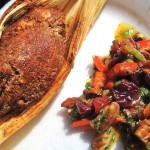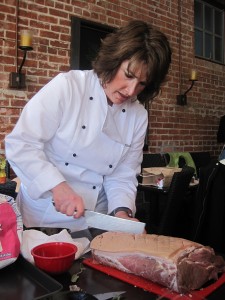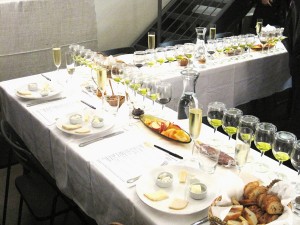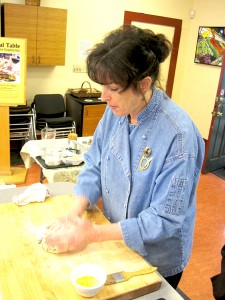Cooking With Class
Posted on May 5, 2010 – 2:52 AM | by OldManFoster Story and Photos by Becky Grunewald
Story and Photos by Becky Grunewald
There are almost as many ways to learn to cook as there are dishes to make. I came to it by necessity. After about the age of 12 I prepared the majority of my family’s meals, in exchange for a pretty hefty allowance. I was taught to cook by my father, who was taught by his mother, a native Nebraskan. She left Nebraska for California-North Highlands, specifically-to follow my grandfather to McClellan Air Force Base.
My grandmother quit school at a young age to keep house for another family, so cooking for a group – even before she had six children of her own – became second nature to her. Time-saving shortcuts slowly crept into her repertoire. By the time I came along she was using Miracle Whip, Jell-o, and canned pie filling routinely, although thankfully not all three at the same time.
Her standard dishes, which I learned to make, were homely fare, mostly Midwestern standards with a few military dishes thrown in by virtue of my grandpa’s stint as a cook. The less said about shit-on-a-shingle the better. I also prepared fried pork chops with Campbell’s soup mushroom ‘gravy’, spaghetti and meatballs with jarred sauce, and meatloaf with ketchup baked on top. Garlic was a banned commodity due to the strong aroma. Spices of any kind came in a McCormick tin. It was the late ‘80s, but we might as well have been living in the ‘50s for all the innovation that was going on in my family kitchen. No sun dried tomatoes or arugula quiches for us!
I’ve come a long way since those days. Now you’ll find homemade preserved lemons in my refrigerator, five or six different types of dried Mexican chilies in my overstuffed spice cabinet, and three kinds of obscure heirloom tomato seedlings straining towards the sun in my kitchen window. Yet there are still glaring gaps in my cooking technique. I’m hopeless with most red meat, and I admit that when things go wrong my Bledsoe pork chops may be served in a salty tear reduction. My bread is usually dense, to put it kindly; “brick-like” may be more apt. I seized on the idea of cooking classes to get me out of my rut.
 The first one that caught my eye was a butchering class offered at Taylor’s Market. Butchers are starting to gain the same media prominence afforded to star chefs, and classes in breaking down meat are popping up in culinary hubs like San Francisco and Portland. It’s only fitting that Taylor’s bring the first such class to Sacramento; this ambitious little market is one of a handful of local businesses dragging Sac toward modernity.
The first one that caught my eye was a butchering class offered at Taylor’s Market. Butchers are starting to gain the same media prominence afforded to star chefs, and classes in breaking down meat are popping up in culinary hubs like San Francisco and Portland. It’s only fitting that Taylor’s bring the first such class to Sacramento; this ambitious little market is one of a handful of local businesses dragging Sac toward modernity.
The owner of Taylor’s himself, Danny Johnson, teaches the class, to a crowd of well-heeled Taylor’s regulars. Johnson starts by emphasizing that he has “chosen to be a butcher, it’s not just a job” and that all his butchers on staff feel the same. His handsome assistant begins to bring out an array of seafood as Johnson gives us tips on how to pick out a good fish. Next he moves on to poultry and deftly and effortlessly parts out a chicken as he talks.
As the display meat gets larger and larger – culminating in the dramatic sight of a headless lamb being cut up with a saw – Danny peppers his talk with irreverent nuggets of wisdom. He doesn’t like West Coast oysters. He won’t buy North American farmed salmon. Heritage turkeys are overrated. Brining is a “trend”. I didn’t learn any hands-on skills in this class, but I was happy to pay just for the unfettered access to Johnson’s encyclopedic knowledge.
A pork-cooking class, also at Taylor’s Kitchen, yields some concrete tips. Paulette Bruce teaches many classes out of this space but is not officially affiliated with Taylor’s. Bruce, an accomplished home cook, begins the class by passing out a book of recipes and briskly instructs us to break into groups. Each group tackles a recipe. My group gets one of the most dramatic-rack of pork arista. We get to carve hatch marks into the thick skin of four, 4-pound center-cut racks of Bledsoe pork under the watchful eye of Paulette. Then we rub a mixture of spices, herbs, and garlic into the cuts and pop it into Taylor’s industrial-sized ovens.
The room buzzes with excited chatter as everyone works on their recipes, and the man himself, John Bledsoe, shows up and holds court in the corner. Has a pig farmer ever been so feted as this man is in Sacramento?
The spice-rubbed pork tenderloin in corn husks with dried cherry salsa emerges from the oven first. The East Sac ladies who make up the class seem to be in a competition to see who can eat the least, but I pig out. Soon the tasty dishes are coming out, one after another. The standout dish is, surprisingly, vegetarian: cayenne-spiked ginger applesauce (for recipe click here).
At 70 bucks, Paulette’s class is one of the more expensive ones around, but this class included a light breakfast, a full lunch of pork, pork and more pork, and enough leftovers for two meals. Also, Paulette is an excellent instructor and her classes are convivial and fun.
 For my next class – a California cheese and olive oil tasting put on by C’est Le Cheese- I again found myself in posh surroundings. I had never expected to enter the legally embattled L street lofts, but there I was, in an untenanted penthouse, sparkling wine in hand, looking down on the hoi polloi below. It was the day that Kevin Martin was traded, and someone pointed out that that meant another penthouse was about to come on the market.
For my next class – a California cheese and olive oil tasting put on by C’est Le Cheese- I again found myself in posh surroundings. I had never expected to enter the legally embattled L street lofts, but there I was, in an untenanted penthouse, sparkling wine in hand, looking down on the hoi polloi below. It was the day that Kevin Martin was traded, and someone pointed out that that meant another penthouse was about to come on the market.
Every lovely place setting had 5 champagne flutes, each containing a different olive oil, and a plate with five cheeses. Savory and sweet accompaniments and baskets of bread were also at hand. Our knowledgeable instructor, Laura Martinez, passed out rating sheets and one-by-one we rated each olive oil for bitterness, pungency, and fruitiness. We also tasted each cheese, both on its own and with the olive oil that Martinez had paired it with. Each time I gulped my wine my flute was promptly refilled.
Maybe it was the Cremant de Limoux going to my head, but I felt as if I had been waiting my whole life for the excuse to guzzle olive oil out of a glass. Actually, I know it was the wine because at the end of the class I spilled mine all over my plate. And dropped cherry jam in my lap. Though my memory of the class is blurred around the edges, I now feel more confident when picking out olive oil and have added more California cheese into my repertoire.
 The surroundings at the Sacramento Natural Foods Co-op class in “hearty winter breads” are more plebian, and subsequently, I feel more comfortable. The SNFC teaching kitchen is in a house across the street from the co-op. The demo room is equipped with video screens so that you can see what the instructor is doing at all times-very pro. Our instructor, Jill Simmons, starts with the science of bread and then moves to the hands-on portion of the class. We knead until our loaves are as smooth as a baby’s bottom. We sample delicious, hot bread, (recipe here.) This class had less chatting, and honestly, I was glad. I think it’s key to take a friend to a cooking class or you end up small-talking with strangers during all the down time.
The surroundings at the Sacramento Natural Foods Co-op class in “hearty winter breads” are more plebian, and subsequently, I feel more comfortable. The SNFC teaching kitchen is in a house across the street from the co-op. The demo room is equipped with video screens so that you can see what the instructor is doing at all times-very pro. Our instructor, Jill Simmons, starts with the science of bread and then moves to the hands-on portion of the class. We knead until our loaves are as smooth as a baby’s bottom. We sample delicious, hot bread, (recipe here.) This class had less chatting, and honestly, I was glad. I think it’s key to take a friend to a cooking class or you end up small-talking with strangers during all the down time.
So overall, what did I gain? I learned how to properly slurp and judge olive oil. I learned how to fry a thick pork chop properly and to not freak out if it’s a little pink, especially if it’s a Bledsoe pork chop. I learned that Danny Johnson at Taylor’s is a badass. I got a magical recipe for beer bread that I have made again and again. Most importantly, I took a few more steps on my personal food journey.
For classes at Taylor’s:
http://www.taylorsmarket.com/gourmet_food_wine_events.asp
For Paulette Bruce’s classes:
www.goodeatscookingclasses.com
For C’est Le Cheese classes:
www.cestlecheese.com
For SNFC classes:
www.sacfoodcoop.com
Tags: Becky Grunewald, C'est Le Cheese, Danny Johnson, Jill Simmons, John Bledsoe Pork, Paulette Bruce, Sacramento Cooking Classes, SNFC Natural Foods Coop Co-op, Taylor's Market


